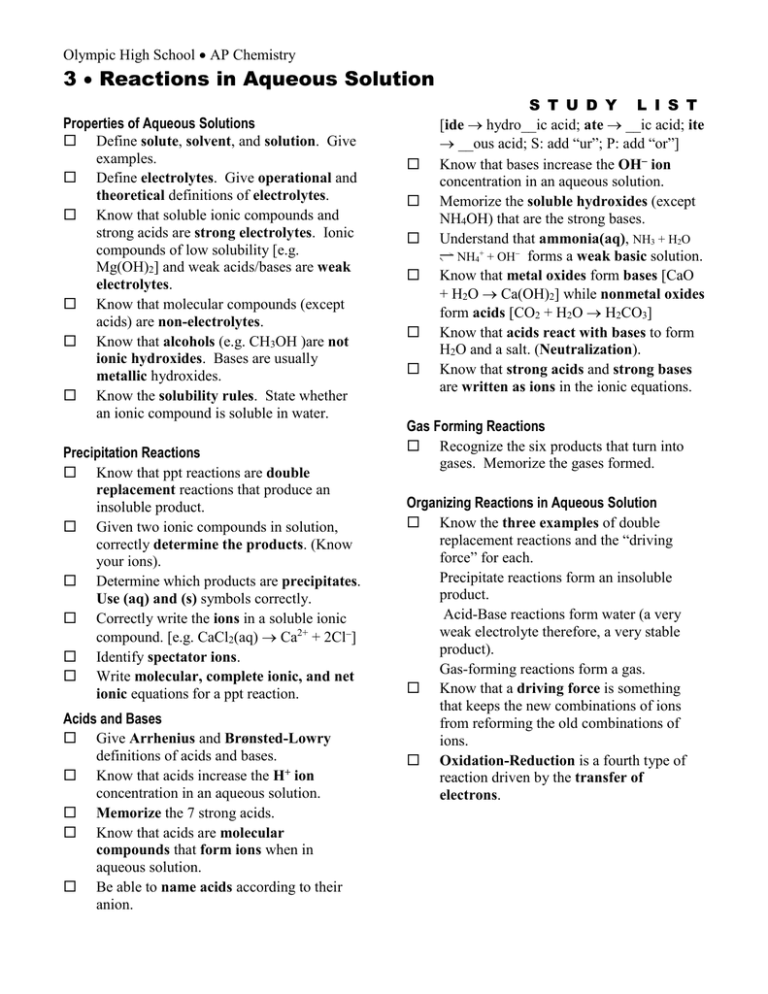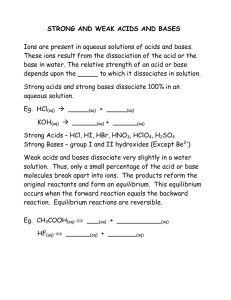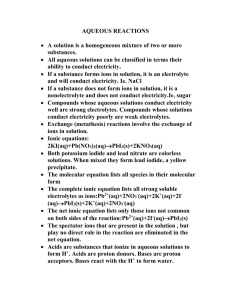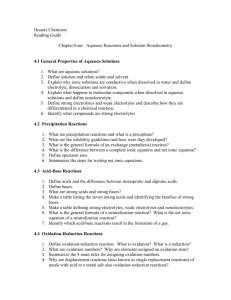3 Reactions in Aqueous Solution
advertisement

Olympic High School AP Chemistry 3 Reactions in Aqueous Solution Properties of Aqueous Solutions Define solute, solvent, and solution. Give examples. Define electrolytes. Give operational and theoretical definitions of electrolytes. Know that soluble ionic compounds and strong acids are strong electrolytes. Ionic compounds of low solubility [e.g. Mg(OH)2] and weak acids/bases are weak electrolytes. Know that molecular compounds (except acids) are non-electrolytes. Know that alcohols (e.g. CH3OH )are not ionic hydroxides. Bases are usually metallic hydroxides. Know the solubility rules. State whether an ionic compound is soluble in water. Precipitation Reactions Know that ppt reactions are double replacement reactions that produce an insoluble product. Given two ionic compounds in solution, correctly determine the products. (Know your ions). Determine which products are precipitates. Use (aq) and (s) symbols correctly. Correctly write the ions in a soluble ionic compound. [e.g. CaCl2(aq) Ca2+ + 2Cl] Identify spectator ions. Write molecular, complete ionic, and net ionic equations for a ppt reaction. Acids and Bases Give Arrhenius and Brønsted-Lowry definitions of acids and bases. Know that acids increase the H+ ion concentration in an aqueous solution. Memorize the 7 strong acids. Know that acids are molecular compounds that form ions when in aqueous solution. Be able to name acids according to their anion. S T U D Y L I S T [ide hydro__ic acid; ate __ic acid; ite __ous acid; S: add “ur”; P: add “or”] Know that bases increase the OH ion concentration in an aqueous solution. Memorize the soluble hydroxides (except NH4OH) that are the strong bases. Understand that ammonia(aq), NH3 + H2O NH4+ + OH forms a weak basic solution. Know that metal oxides form bases [CaO + H2O Ca(OH)2] while nonmetal oxides form acids [CO2 + H2O H2CO3] Know that acids react with bases to form H2O and a salt. (Neutralization). Know that strong acids and strong bases are written as ions in the ionic equations. Gas Forming Reactions Recognize the six products that turn into gases. Memorize the gases formed. Organizing Reactions in Aqueous Solution Know the three examples of double replacement reactions and the “driving force” for each. Precipitate reactions form an insoluble product. Acid-Base reactions form water (a very weak electrolyte therefore, a very stable product). Gas-forming reactions form a gas. Know that a driving force is something that keeps the new combinations of ions from reforming the old combinations of ions. Oxidation-Reduction is a fourth type of reaction driven by the transfer of electrons. Oxidation-Reduction Reactions Fe2O3 + 3 CO 2 Fe(s) + 3 CO2 Know that an important type of reaction gets its name from atoms that combine with oxygen. During the refining of iron, carbon monoxide combines with oxygen (from the iron ore), CO CO2 and is oxidized. Large masses of iron ore (Fe2O3) are reduced to a smaller amount of iron metal. Know that oxidation-reduction (redox) is driven by the transfer of electrons. Mnemonics to help:); \ LeO goes GeR (Losing e’s = Oxidation / Gaining e’s = Reduction); OIL RIG (Oxidation is Losing e’s / Reduction is Gaining e’s) A redox reaction can be divided into two half-reactions. The oxidation halfreaction has electrons as a product. The reduction half-reaction has electrons as a reactant. Be able to assign oxidation numbers to any atom in any substance. Learn the rules on page 207. Recognize redox reactions because oxidation numbers change. (# = oxidation / # = reduction), electrons are gained or lost, or oxygen atoms are gained or lost. Know several common oxidizing agents and reducing agents and what they turn into. .






